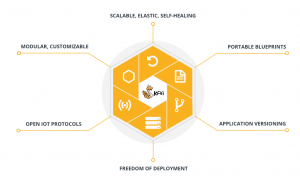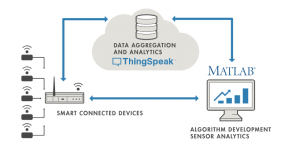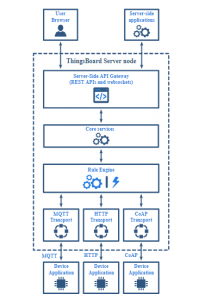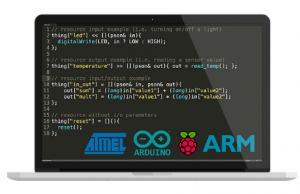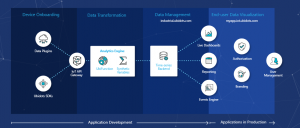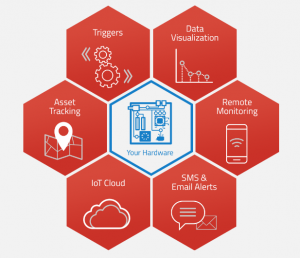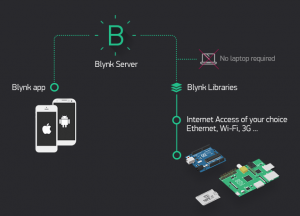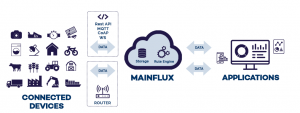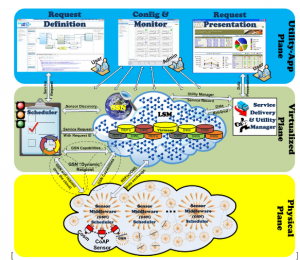What is IoT ? or What is Internet of Things ?
The Internet of Things (IoT) is the network of things (physical devices, vehicles, home appliances, and other items embedded with electronics, software, sensors, actuators) connected through internet which enables these things to exchange data. This creates opportunities for more direct integration of the physical world into computer-based systems, resulting in efficiency improvements, economic benefits, and reduced human exertions.
Simply we can say IoT is a system of things integrated with sensors, software's, electronics which are connected to each other & can exchange data or Information with other connected devices.
What do you mean by IoT platforms?
The IoT platforms are suites of components those help to setup and manage the internet connected devices to remotely collect data, monitor and manage all internet connected devices from a single system. IoT platforms are the support software that connects everything in an IoT system. An IoT platform facilitates communication, data flow, device management, and the functionality of applications.
I have covered the major enterprise IoT platform companies and few open source Internet of things platforms in the article top IoT platform companies.
In this article we will talk about some of the best and well-known open source Internet of things and open source iot platform comparison.
10 Top Open Source IoT Platform :
-
Kaa IoT Platform
Kaa is an enterprise-grade IoT platform built on a modern cloud-native architecture and a fully customizable feature set. Based on flexible microservices, Kaa easily adapts to almost any need and application. It scales from a tiny start-up to a massive corporation and supports advanced deployment models for multicloud IoT solutions.
Kaa is a highly flexible, multi-purpose, 100% open-source middleware platform for implementing complete end-to-end IoT solutions, connected applications, and smart products. For a quick start, Kaa offers a set of out-of-the-box enterprise-grade IoT features that can be easily plugged in and used to implement a large majority of the IoT use cases. The platform features include device management, data collection, configuration management, messaging, and more.The Kaa IoT platform is licensed under Apache Software License 2.0. See LICENSE and copyright.txt for details.
Kaa Key IoT features:
- Modern microservice architecture : Simplifies customization and ensures effective separation of concerns between different parts of the platform
- Freedom of technology: You can use your favorite programming languages and DevOps tools
- Scalable, elastic, and self-healing: Enterprise-grade scalability and resilience
- Freedom of deployment: Public, private, or mixed cloud deployment on any infrastructure of your choice
- Open IoT protocols: The platform runs on open protocols, supports MQTT by default
- Security: TLS or DTLS by default, flexible credentials lifecycle management
- Blueprints: Enable the Infrastructure as Code approach for managing your clusters
Kaa is one of the best IoT platforms open source newly in the market, you have both community version and enterprise version available.
Website: https://www.kaaproject.org/
-
ThingSpeak (open IoT platform with MATLAB analytics)
ThingSpeak™ is an IoT analytics platform service that allows you to aggregate, visualize and analyze live data streams in the cloud. ThingSpeak provides instant visualizations of data posted by your devices to ThingSpeak. With the ability to execute MATLAB® code in ThingSpeak you can perform online analysis and processing of the data as it comes in. ThingSpeak is often used for prototyping and proof of concept IoT systems that require analytics.
ThingSpeak Key Features:
ThingSpeak allows you to aggregate, visualize and analyze live data streams in the cloud. Some of the key capabilities of ThingSpeak include the ability to:
- Easily configure devices to send data to ThingSpeak using popular IoT protocols.
- Visualize your sensor data in real-time.
- Aggregate data on-demand from third-party sources.
- Use the power of MATLAB to make sense of your IoT data.
- Run your IoT analytics automatically based on schedules or events.
- Prototype and build IoT systems without setting up servers or developing web software.
- Automatically act on your data and communicate using third-party services like Twilio® or Twitter®
Website: https://thingspeak.com/
-
Thingsboard.io
ThingsBoard is an open-source IoT platform for data collection, processing, visualization, and device management. ThingsBoard is an open-source IoT platform that enables rapid development, management and scaling of IoT projects. The goal is to provide the out-of-the-box IoT cloud or on-premises solution that will enable server-side infrastructure for your IoT applications.
It enables device connectivity via industry standard IoT protocols - MQTT, CoAP and HTTP and supports both cloud and on-premises deployments. ThingsBoard combines scalability, fault-tolerance and performance so you will never lose your data.
Thingsboard Key Features:
- Scalable: horizontally scalable platform, build using leading open-source technologies.
- Fault-tolerant: no single-point-of-failure, every node in the cluster is identical.
- Robust and efficient: single server node can handle tens or even hundreds thousands of devices depending on use-case. ThingsBoard cluster can handle millions of devices.
- Customizable: adding new functionality is easy with customizable widgets and rule engine nodes.
- Durable: never lose your data.
Refer the documentation to get the complete details about Thingsboard. We will be using Thingsboard community edition for our IoT Projects and is free iot platform raspberry pi, arduino etc..
-
Thinger.io
Thinger.io is an open source platform for internet of things,Connect and Manage your Internet of Things products within minutes.They offer a ready to go scalable cloud infrastructure for connecting millions of devices. You can control them with our easy to use admin console, or integrate them in your business logic with our REST API.
Thinger IoT Patform Key Feature:
- Open Source: Install the server in your own cloud and use the Open Source libraries for connecting your devices.
Website: https://thinger.io/
-
Ubidots
Ubidots offers a platform for developers that enables them to easily capture sensor data and turn it into useful information. Connect, Develop, and Deploy IoT Applications with Ubidots Intuative IoT Development Platform.System Integrators and OEMs effortlessly self-construct Internet of Things (IoT) applications and products with Ubidots’ data collection, analysis, and visualization tools to deliver agile solutions that improve a company’s KPIs and/or services.
Ubidots IoT platform Key Feature:
- Easily Connect: Connect your hardware and/or digital data-services to Ubidots’ device agnostic cloud with our REST API and deliver customized IoT and Cloud solutions the way you want.
- Device friendly API and SDKs: Connect hardware to Ubidots cloud easily with more than 200 user-proven libraries, SDKs, and tutorials to guide your integration over HTTP, MQTT, TCP, UDP, or by Parsing custom/industrial protocols.
- Point-and-click Cloud Application Development: Develop your business’ solutions with Ubidots’ intuitive, code-free application development tools: Rules & Events Engine, Scheduled Reporting, Real-time dashboards, and more.
- White-label customer-specific Applications: Deploy custom applications to end-users with your Company’s branding, URLs, colors plus customize alert messages, languages, and more to deliver your solutions the way you want.
- User Management : With Ubidots cloud software, administrators self-build applications to best fit the operator's needs. Assign permissions and restrictions to any end-user or operator who interacts with dashboards, devices, and/or events.
Website: https://ubidots.com/
-
Cayenne
Mydevices Cayenne:
When we hear cayenne first things comes is Porsche Cayenne or Cayenne Pepper for those are food crazy :). That is not what talking here, we are talking about MyDevices Cayenne who claims that they are the first drag and drop IoT Project builder. Cayenne is the world’s first drag and drop IoT project builder that empowers developers, designers and engineers to quickly prototype and share their connected device projects. Cayenne was designed to help users create Internet of Things prototypes and then bring them to production.
Design prototypes and complete IoT solutions with my device Cayenne app in any device or connection.Cayenne IoT ready program for hardware manufacturers will easily enable micro controllers , gateways, sensors and other devices to connect to Internet of Things. Refer the tutorial on simple iot drag and drop app builder cayenne app to know about the detail process on how to sign up in Cayenne and configure for your IoT projects. This is one of the best IoT platform for raspberry pi which is easy and not much programming required.
Mydevices Cayenne Key Features:
- Triggers
- Data Visualization
- Remote Monitoring
- SMS & Email Alerts
- IoT Cloud
- Asset Tracking
-
Blynk
Blynk is a Platform with iOS and Android apps to control Arduino, Raspberry Pi and the likes over the Internet.
It's a digital dashboard where you can build a graphic interface for your project by simply dragging and dropping widgets.
It's really simple to set everything up and you'll start tinkering in less than 5 mins.
Blynk is not tied to some specific board or shield. Instead, it's supporting hardware of your choice. Whether your Arduino or Raspberry Pi is linked to the Internet over Wi-Fi, Ethernet or this new ESP8266 chip, Blynk will get you online and ready for the Internet Of Your Things.
You can download Blynk app from below links and it is one of the best free iot platform for arduino.
Free Blynk app from IOS App store and Play Store.
Blynk IoT Platform Key Features:
- Similar API & UI for all supported hardware & devices
- Connection to the cloud using:
- WiFi
- Bluetooth and BLE
- Ethernet
- USB (Serial)
- GSM
- Set of easy-to-use Widgets
- Direct pin manipulation with no code writing
- Easy to integrate and add new functionality using virtual pins
- History data monitoring via SuperChart widget
- Device-to-Device communication using Bridge Widget
- Sending emails, tweets, push notifications, etc.
Website: https://www.blynk.cc/
-
Mainflux
Mainflux is highly secure, scalable, open-source IoT platform written in Go and deployed in Docker. It serves as software infrastructure and set of microservices for development of the Internet of Things Solutions and deployment of Intelligent products.
Mainflux is an open-source IoT cloud platform for the development of Internet of Things solutions, IoT applications and intelligent products. Mainflux software infrastructure stack contains all necessary components and microservices required for fully functional IoT solutions. The IoT Cloud Platform will facilitate the interoperability of the IoT solution with existing enterprise applications and other IoT solutions.
Mainflux IoT Platform Key Feature:
- Responsive and scalable architecture based on a set of microservices
- Set of clean APIs: HTTP RESTful, MQTT, WebSocket and CoAP
- SDK - set of client libraries for many HW platforms in several programming languages: C/C++, JavaScript, Go and Python
- Device management and provisioning and OTA FW updates
- Highly secured connections via TLS and DTLS
- Enhanced and fine-grained security via deployment-ready Mainflux Authentication and Authorization Server with Access Control scheme based on customizable API keys and scoped JWT
- Easy deployment and high system scalability via Docker images
- Clear project roadmap, extensive development ecosystem and highly skilled developer community
Website: https://www.mainflux.com/
-
WSo2
WSO2 is an open source technology provider. It offers an enterprise platform for integrating APIs, applications, and web services locally and across the Internet. WSO2 Named a Leader in The Forrester Wave™: API Management Solutions, Q4 2018 Report.The WSO2 Integration Agile Platform is a broad framework to develop, reuse, run and manage integrations. It's architected around a common code base of fully open source integration technologies. Components can be used individually, or as a cohesive integration-agile platform
WSo2 Key Features:
- First-in-the-industry integration agile methodology: Our agile transformation methodology helps IT transform to an integration agile model. You get faster releases and quicker responsiveness to the business.
- Unique open source technology and licensing: Unlike open core products, our approach to open source ensures the benefits of community contributions, freedom from cloud lock-in, and the value-add of support patch binaries.
- Broadest integrated platform: No need to mix-and-match different API management, integration, identity, analytics or microservice technologies from multiple vendors. We offer a common architecture across all of them.
Website: https://wso2.com/
-
OpenIoT
OpenIoT is perceived as a natural extension to cloud computing implementations, which will allow access to additional and increasingly important IoT based resources and capabilities. OpenIoT is pertinent to a wide range of interrelated scientific and technological areas spanning: (a) Middleware for sensors and sensor networks, (b) Ontologies, semantic models and annotations for representing internet-connected objects, along with semantic open-linked data techniques (c) Cloud/Utility computing, including utility based security and privacy schemes.
OpenIoT is simple to use, connect all your sensors and make them a natural extension of your IoT solution, enabling accessibility to IoT based resources,enabling accessibility to IoT based resources and their capabilities.
Open IoT Key Features:
- Easy to use and deploy IoT agent
- Inbuilt dashboard to create rules, graphs and catalog items
- Full RESTful JSON API supported
- Realtime actuations (cloud -> IoT device)
Website: http://www.openiot.eu/
We have seen a huge amount of details in this tutorial, the major IoT platform open source comparison. I have tried to cover as much as possible information received on each platform incorporated here. Go through individual platform websites for more information and select which open source IoT platform is suitable for your needs.Hoping the above open source IoT platform comparison table gives a of you information to start your IoT Projects.
